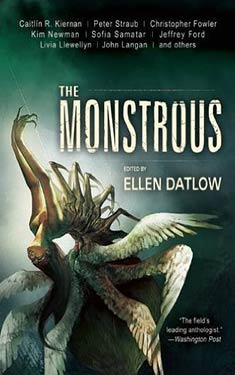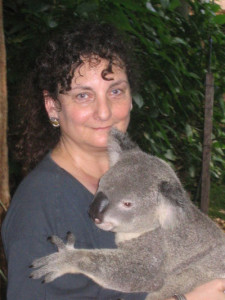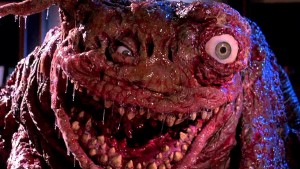The Monstrous: Ellen Datlow Presents the Nature of the Beast
 Had this book been titled Ellen Datlow’s Big Book of Monsters, there is little chance I would have picked it up. Not that I don’t love monsters. I am, in fact, a monster kid.
Had this book been titled Ellen Datlow’s Big Book of Monsters, there is little chance I would have picked it up. Not that I don’t love monsters. I am, in fact, a monster kid.
When I was five years old, previews for I Was a Teenage Frankenstein, The Blob, Attack of the Killer Shrews and their ilk flowed through the boxy, black-and-white television sets in dens and family rooms across the United States. Each of these creations looked potentially more marvelous that the one promoted the week before; and, once my parents made it clear that under no circumstances would I be allowed to attend these films, my fate was sealed. To this day, I will program the DVR to record almost any unfamiliar offering from the SyFy Channel or Chiller Network and watch it just long enough to see whatever ridiculous creature will be wreaking unconvincing CGI’d mayhem for the remainder of the two-hour time slot. Because really what I care about is that moment when the monster is revealed. I want to see the experiment gone wrong that’s kept chained in the cellar; the alien that emerges from the wrecked spacecraft; or, Godzilla’s latest sparring partner. After that first reveal, I have slowly learned over the decades to expect things to go downhill. But my enthusiasm for that first look has never waned.
My monster addiction is a visual thing. I have never cared much for monster stories. Verbal descriptions of the hideous tend to be anti-climactic and take too long. By the time I was twelve I quit expecting any of this stuff to be scary, but I want either an impressive crudeness or elegance to the creature, and I want to take it in at a glance. (And I will forestall some criticism here by saying that Clive Barker writes excellent monsters, China Mielville creates admirably alien aliens, and The Babadook recently scared the bejezzus out of me.)
By titling her new anthology The Monstrous, Ellen Datlow drew me in. She seemed to be promising “essence of the monster” rather than just the doings of the things themselves. And after editing what, something like 800 anthologies, I know that she knows her stuff. These are twenty-one stories that, while they will not duplicate the thrill of witnessing Ray Harryhausen’s Kraken lift its third arm out of the sea, can still satisfy the monster kid in all of us – and I know you are out there.
In her introduction, Datlow says she was looking for unusual monster stories, but she has not avoided such familiar creatures as vampires, serial killers, and ancient evils haunting tombs best left unopened. For the most part, her authors don’t depict creatures that depend on detailed description of their hideousness for effect. Adam-Troy Castro’s “The Totals,” features the widest array of nightmarish creatures, each tailor-made to terrify and inflict painful death on innocent victims. But his story is played for laughs. We meet them in an all-night diner where they gather to collect their weekly bonus pay. The comedy here stands out in three hundred pages of grimmer, sadder, bleaker stuff.
Datlow frontloads the anthology with literary firepower. Jeffrey Ford’s “A Natural History of Autumn” incorporates Japanese folklore into the high-stakes, globalized corporate world. Peter Straub offers a brilliant retelling of “Ashputtle,” the Grimm’s brothers version of the Cinderella story with the prince, the ball, and the happy ending replaced with a contemporary tale of life-long revenge carried out by an obese, homicidal kindergarten teacher. Caitlín Kiernan’s “The Beginning of the Year Without Summer” is a beautifully written, evocative tale, but – and I have had this experience before with Caitlín Kiernan – I am not quite sure what it’s about.
In any group of monster stories, curses will abound. In Gemma Files’ “A Wish from a Bone,” a group of archeologists who are also interested in careers on reality TV, open an ancient tomb to spectacularly dire results. One of the first of the crew to be possessed sprouts wings and spends the rest of the story flapping about overhead with her lungs dangling from her shattered chest cavity. Now that’s a cinematic image worthy of Eli Roth. The philosophical but ruthless vampire in Jack Dann’s and Gordner Dozios’ “Down Among the Dead Men” can be killed but his infection cannot. Stephen Graham Jones turns in a typically visceral tale set on a western-bound wagon train with a creature so foul that even his bleached bones pass on his monstrosity.
I have a couple of favorites: Sofia Samatar’s “How I Met the Ghoul” and John Langan’s “Corpsemouth.” In Samatar’s five-age vignette an understandably nervous reporter interviews an ancient, dangerous creature in an airport coffee shop. Both the reporter and the monster are in their way engaging characters.
Langan’s first person narrative takes a leisurely, novelistic approach and describes a family trip to visit the Scottish relatives of a young man’s recently deceased father. (Anyone who watches movies on the Chiller channel would know this is not a good idea.) The visit is a pleasant round of aunts, uncles, and cousins from several generations, all of whom offer dinners, single malt scotch, and sightseeing. One elderly great-uncle also tells the story of Corpsemouth, a creature from the days of King Arthur. It’s an ancient tale that will prove to have contemporary implications that tie the narrator to familial duties he has never imagined. This is a kind of curse, but on another level it is a monster kid’s dream come true.
(This review is based on an advanced ebook provided by Net Galley.)



















 Full Details
Full Details




No comments yet.
Sorry, the comment form is closed at this time.